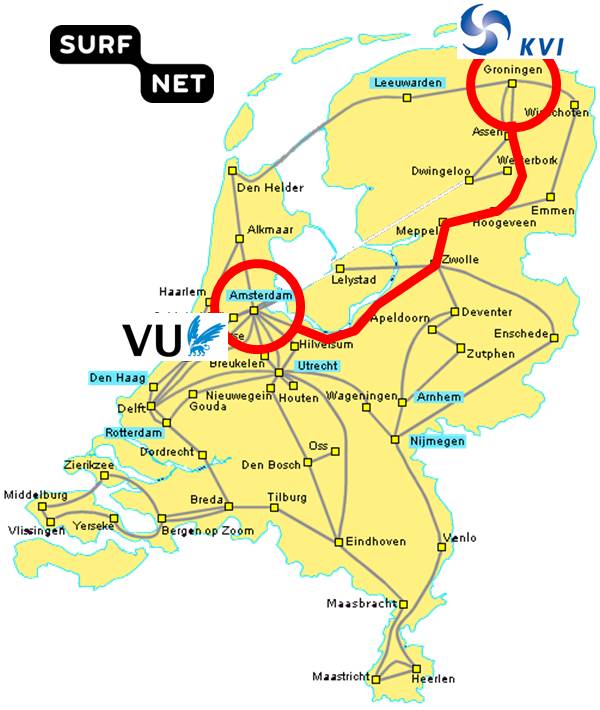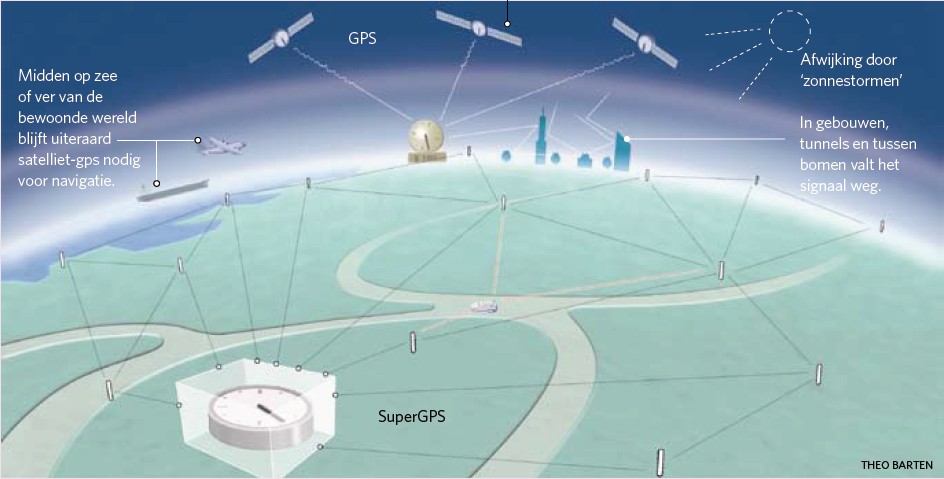
SuperGPS through optical networks
Jump to list of projects and collaboratorsWhat is SuperGPS?
The name SuperGPS refers to a system currently under development at LaserLaB VU and at Delft University of Technology. SuperGPS essentially follows the same principle of operation as global navigation satellite systems (GNSS) like the U.S. GPS and European Galileo: it broadcasts timing information obtained from very accurate atomic clocks to a group of users. An important difference, however, is that SuperGPS does not use satellites in orbit that broadcast radio signals. Instead, it uses the telecommunication fiber-optic network to transmit time and frequency in the form of optical (laser) signals. Therefore, these time signals do not have to propagate all the way from space, through the Earth's turbulent atmosphere, to Earth like GNSS radio signals. Instead, SuperGPS signals travel through relatively quiet and well-controlled telecom optical fibers. Indeed, recent experiments by colleagues in Germany and France (among others) have shown that frequency transfer through optical fiber can be orders of magnitude more stable than achievable via satellite transmission. Another difference between GNSS and SuperGPS is that where GNSS satellites -some thirty in total per GNSS- each contain a few atomic clocks that need to be synchronized to the 'atomic time' on Earth through radio transmissions, SuperGPS basically requires only one accurate atomic clock that is connected to the optical network.
Essential timing for everyday-life services
GNSS are probably best known for enabling positioning and navigation with small, hand-held devices. Yet, GNSS play another important role in our modern society. Several contemporay network technologies use GNSS for network synchronization. Without GNSS, everyday-life services such as electric power grids, (mobile) Internet, and navigation and positioning would become very hard to realize -if not impossible at all. Over the past decades, network technologies have followed a trend towards ever larger networks with ever higher data transmission capacity. Faster processes and data transmission rates in the network require tighter synchronization of network nodes in order to keep up with all the network activity, and enable efficient mobile telecommunications protocols, such as 4G LTE-TDD. In principle one could equip each node with a sufficiently accurate atomic clock to achieve this. However, even atomic clocks need to be synchronized to a common time scale every now and then. Furthermore, the cost of a solution based on individual clocks increases rapidly as the size of a network grows. This explains the success of network synchronization through GNSS: GNSS signals are accurate and available everywhere with a clear view to the sky, and they are all related to a common time scale. However, GNSS accuracy is not unlimited, and the atmospheric disturbances pose a bottleneck on the performance and speed of future network technologies. This is where SuperGPS may become useful: a system for extremely accurate timing and synchronization, that is embedded within the very network itself.
Timing back up
Another advanage of SuperGPS is that the optical network cannot be easily tampered with. For example, a radio jammer would not affect the optical fiber transmission, whereas it would jam GNSS radio signals. Likewise, if GNSS would fail for some reason (for instance due to very heavy solar storms, also known as Carrington Events), the SuperGPS system could provide an independent timing back up. This back-up functionality could be of importance to a variety of technologies, ranging from power grids to financial markets. Recently, a collaboration between VU Amsterdam, TU Eindhoven, and SURFnet resulted in a demonstration of an optical wavelength channel capable of simultaneous time transfer with 4 ps uncertainty and data transfer with 10 Gb/s, through an fiber-optical link of 75 km length. This indicates that ps-level time transfer and high-capcity data transmission may be integrated into one system.
Next-generation positioning?
GNSS are probably best known for providing radio signals for positioning and navigation. GNSS do so by adding accurate position information to their timing signals. If a GNSS receiver 'sees' at least four GNSS satellites, it is able to combine the time and position information of all satellites to determine its location (x,y,z) and local time t. However, again the Earth's atmosphere limits the accuracy that can be achieved. Standard GNSS receivers (e.g. inside cars) are accurate to 5-10 meters at best. Things get worse quickly when entering an 'urban canyon' in between tall buildings, as signal reflections bouncing off buildings and objects confuse the receiver. Combined with the fact that GNSS signals are relatively weak, GNSS cannot be used inside buildings, road tunnels and industrial plants. This is where SuperGPS may make a difference. The optical network can be extended with a grid of antenna masts, that are connected and synchronized to the optical network. These antennae may act as 'pseudolites', broadcasting their time and position information to users. These antennae could be similar to mobile telecom transceivers, or integrated with them. Their signals may be tailored so that receivers can distinguish between the signal and its reflections, and the signals may be received indoors - just like your mobile phone signal. This opens up the possibility of navigation under circumstances where GNSS ceases to function, like on busy highways or inside buildings. In such cases, enhanced terrestrial positioning through SuperGPS Could augment GNSS functionality in urban regions.
Research at LaserLaB VU
LaserLaB VU has deployed several research activities towards time and frequency dissemination through optical fiber, and its application to SuperGPS. See also the list of Jump to list of projects
below.
|
The 2 x 300 km SURFnet fiber link between VU and RUG/KVI
|
Artist's impression of SuperGPS (c) NWT MAgazine (2012)
|
Ongoing projects:
In this project we collaborated with SURFnet to realize two long-haul fiber-optic connections in the Netherlands. Since 2011, a 300-km-long fiber link has been operational between VU Amsterdam and University of Groningen (Netherlands), which was developed for the FOM Program Broken Mirrors and Drifting Constants. This link consists of a single DWDM channel through a pair of of optical fibers, and is provided and maintained by the Dutch education and research network SURFnet. Recently we studied the achievable passive time and frequency transfer stability of such a standard telecom link, which for buried fiber appears to be limited by soil temperature variations (which can be removed by relatively simple interferometric techniques). A second fiber link was realized in 2013 and connects the Dutch metrology institute VSL at Delft with the Nikhef institute at Amsterdam. This fiber link contains bidirectional optical amplifiers, developed and tested in collaboration with SURFnet and Eindhoven University of Technology, based on semiconductor amplifiers, and distributes time and frequency in the form of 1 Gb/s optical Ethernet data through CERN's White Rabbit protocol. The first results of this link were recently reported.
The ASTERICS project will develop efficient methods to acquire, process and combine large amounts of astronomical data from different facilities, and make these widely available to scientists and members of the public. One subtask of the project aims to synchronize radio telescopes in Dwingeloo and Westerbork through SURFnet optical fiber. This technology will allow perfectly synchronized observations with large facilities in different locations on the continent, even while looking at different signals ('multi-messenger' astronomy).
The SuperGPS project targets the development of 'terrestrial GPS'. Like the Global Positioning System, it will provide wireless signals for positioning and clock synchronization. However, the accuracy and coverage of SuperGPS will go significantly beyond the performance of existing GPS. This will be achieved by a grid of innovative ultra-wideband transmitters, connected and synchronized to an accurate atomic clock through the fiber-optic telecommunications network. Ultimately, this should lead to an ICT infrastructure which does not only provide high-capacity connectivity, but also very accurate positioning and timing. The research will conducted by VU Amsterdam and TU Delft, in collaboration with KPN, VSL, SURFnet, TNO, Fugro Geoservices, and OPNT. A field trial of SuperGPS at the TNO test site (A270 highway) is planned, in order to demonstrate positioning with 10 cm accuracy under real-life conditions.
Collaborations with:
Delft University of Technology
Eindhoven University of Technology
University of Groningen
SURFnet
VSL
JIVE-ERIC
Nikhef
ASTRON
University of Granada (Spain)
White Rabbit project (CERN)
Back to Jeroen's homepage

